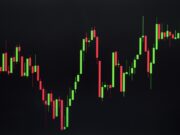The escalating trade tensions have created ripple effects across various market sectors, forcing investors to recalibrate their strategies. Our analysis points to several key developments worth monitoring, from defensive retail opportunities to troubling signals in the Treasury market.
Walmart (WMT): Essential Retail With Defensive Characteristics
The consumer staples sector has historically provided shelter during market turbulence, and our current environment appears no exception. Despite facing some exposure to recently imposed 104% tariffs on Chinese imports, Walmart stands out as a resilient option in today’s volatile landscape.
What makes Walmart particularly attractive now is its dominant grocery business, which accounts for over half of its U.S. sales. As G-Squared’s investment strategists noted in recent conversations, “basic necessities purchasing remains consistent regardless of economic conditions.” This provides Walmart with defensive characteristics that many other retailers lack.
The company’s scale and purchasing power also position it to better absorb or mitigate tariff impacts compared to smaller competitors. While no retailer is completely insulated from trade disruptions, Walmart’s massive distribution network and vendor relationships give it significant negotiating leverage.
Technically, the stock has demonstrated relative strength against broader market indices during recent volatility, suggesting institutional investors are already positioning for prolonged economic uncertainty.
Costco (COST): Membership Model Creates Revenue Predictability
Another standout in the current environment is Costco, whose subscription-based business model adds another layer of revenue stability during uncertain times. The membership renewal rate exceeds 90% in the U.S. and Canada, providing remarkable visibility into future customer traffic.
Value-conscious consumers historically flock to warehouse clubs during economic slowdowns, potentially accelerating Costco’s already impressive same-store sales growth. The company’s limited SKU strategy (carrying fewer products in larger quantities) also gives it meaningful bargaining power with suppliers to help offset tariff-related cost increases.
According to retail analysts we’ve consulted, Costco’s bulk purchasing model becomes even more attractive to consumers when inflation concerns rise. “When household budgets tighten, the perceived value of buying in bulk intensifies,” making Costco a potential beneficiary of current economic anxieties.
Treasury Market Warning Signs: The Next Battleground?
Looking beyond equities, fixed income markets warrant close attention in the coming days. The Treasury Department has scheduled critical auctions this week – $39 billion in 10-year notes Wednesday followed by $22 billion in 30-year bonds Thursday.
These auctions take on heightened significance against the backdrop of trade tensions. Financial analysts at Jefferies have raised concerns about potential retaliation through reduced foreign participation in U.S. debt markets, particularly from affected trading partners.
“The weaponization of financial markets represents an escalation that few investors have adequately prepared for,” noted one fixed income strategist. If foreign buyers reduce their Treasury purchases, yields could rise unexpectedly, creating a negative feedback loop for both bonds and equities.
Trade War Trajectory: More Disruption Ahead?
The implementation of triple-digit percentage tariffs has surprised even seasoned trade policy experts. Former high-ranking commerce officials who previously predicted tariff reductions by mid-2025 now acknowledge we’ve entered “territory that no one expected.”
The sustainability of these measures remains the crucial question. Trade policy veterans warn that “the more time that passes, the more structural damage occurs to supply chains,” suggesting investors should prepare for prolonged disruption rather than a quick resolution.
This evolving situation demands portfolio adjustments that balance defensive positioning with the flexibility to adapt to rapidly changing conditions. The consumer staples sector, particularly through retailers with grocery strength, offers one potential shelter, while fixed income investors should remain alert to unusual auction dynamics that might signal further escalation.










